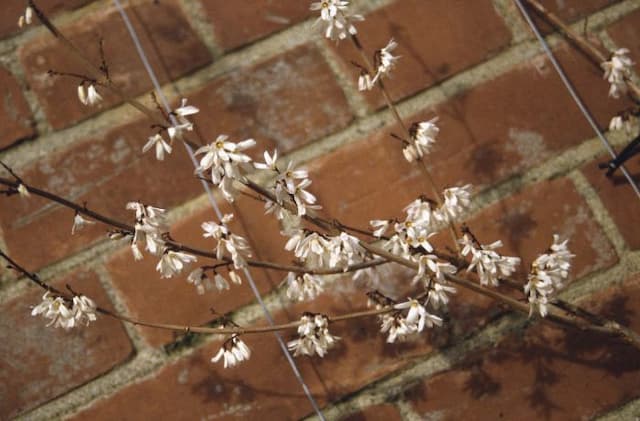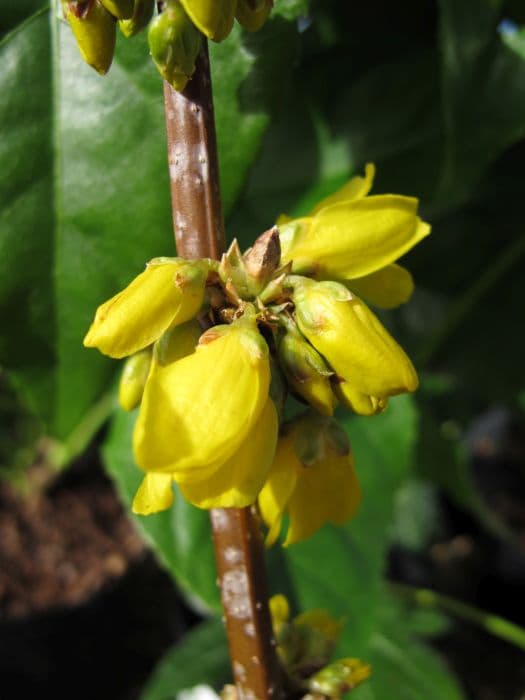Lilac Syringa × josiflexa 'Agnes Smith'

ABOUT
The plant commonly known as 'Agnes Smith' is notable for its elegant and alluring features. It is a hybrid with a graceful appearance, characterized by a profusion of flowers that bloom in the spring. The blossoms are typically a pristine white, which stand out vividly against the green foliage. These flowers are not only eye-catching but are also fragrant, often filling the surrounding air with a pleasantly sweet scent that attracts pollinators as well as garden admirers. The foliage of 'Agnes Smith' consists of heart-shaped leaves that exhibit a fresh green hue. The leaves provide a lush backdrop for the brilliant white blooms, and they hold their color well throughout the growing season, often turning to appealing shades as the season progresses. As a cultivar, 'Agnes Smith' displays a form that could be defined as upright and rounded, giving it a well-structured look that can add an air of sophistication to any garden setting. Its branches are sturdy, supporting the weight of the flowers and foliage with ease. The overall appearance of 'Agnes Smith' is one that combines the romantic allure of its flowers with the sturdy elegance of its growth habit, making it a cherished addition to gardens where it can be accommodated.
About this plant
 Names
NamesFamily
Oleaceae
Synonyms
Agnes Smith Lilac, Josee Reblooming Lilac
Common names
Syringa × josiflexa 'Agnes Smith'.
 Toxicity
ToxicityTo humans
The plant commonly known as Lilac, including the Syringa × josiflexa 'Agnes Smith' variety, is not considered to be highly toxic to humans. However, in some cases, ingestion of parts of a Lilac plant may cause mild stomach upset. Generally, the plant is not considered a health threat, and serious consequences are rare.
To pets
The Lilac plant, Syringa × josiflexa 'Agnes Smith', is also not considered highly toxic to pets. If pets ingest parts of this plant, they might experience some gastrointestinal upset, but Lilacs are generally not known to cause severe poisoning or life-threatening situations in animals. It is always advisable to monitor pets to avoid ingestion of plants, as individual sensitivity can vary.
 Characteristics
CharacteristicsLife cycle
Perennials
Foliage type
Deciduous
Color of leaves
Green
Flower color
White
Height
8 feet (2.44 meters)
Spread
6 feet (1.83 meters)
Plant type
Shrub
Hardiness zones
4
Native area
Cultivar
Benefits
 General Benefits
General Benefits- Aesthetic Appeal: The Syringa × josiflexa 'Agnes Smith', commonly known as the Lilac, has beautiful white blossoms that enhance the visual appeal of any garden.
- Fragrance: Lilacs are well-known for their strong and sweet fragrance that can perfume the air in the surrounding area.
- Attracts Pollinators: Lilacs attract bees, butterflies, and other beneficial pollinators, which are essential for the health of the ecosystem and the pollination of many other plants.
- Low Maintenance: Lilacs are generally easy to care for and require minimal upkeep once established, making them an excellent choice for both novice and experienced gardeners.
- Privacy Screen: When planted in a row or as a hedge, lilacs can provide a natural screen that offers privacy and reduces noise pollution.
- Shade Tolerance: Lilacs can tolerate partial shade, although they do best in full sun, which makes them versatile in different garden designs and locations.
- Durability: These plants are hardy and can withstand cold temperatures, which makes them suitable for many climates.
- Cut Flowers: The blossoms of the lilac make excellent cut flowers for indoor arrangements, retaining their fragrance and adding a touch of spring to your home.
- Longevity: With proper care, lilac bushes can live for many years, providing lasting enjoyment with minimal need for replacement or extensive gardening interventions.
 Medical Properties
Medical PropertiesThis plant is not used for medical purposes.
 Air-purifying Qualities
Air-purifying QualitiesThis plant is not specifically known for air purifying qualities.
 Other Uses
Other Uses- As a natural dye: Syringa blossoms can be used to create a light green dye for textiles, when properly prepared and applied.
- Culinary flavoring: In some regions, lilac flowers are used to impart a floral flavor to desserts and jellies.
- Decorative crafts: Dried lilac flowers are sometimes incorporated into potpourri mixes or used in homemade soaps for their fragrance and color.
- Insect-repelling properties: While not as common, some gardeners believe the scent of lilacs may deter certain insects, though evidence is anecdotal.
- Perfumery: The petals of lilac can be used to make a fragrant water or oil, which is sometimes used in making perfumes or scented sachets.
- Floral arrangements: 'Agnes Smith' is known for its attractive blooms that are used in cut flower arrangements.
- Garden design: Often used as a focal point in landscape designs for its appealing visual and fragrant display.
- Habitat support: The shrub provides cover and nesting sites for birds within a garden setting.
- Artistic inspiration: The beauty of lilacs has been celebrated in poetry, paintings, and photography, serving as a muse for various artists.
- Symbolism and tradition: Lilacs have various symbolic meanings, such as the beauty of youth or first love, and are often used in events to convey these messages.
Interesting Facts
 Feng Shui
Feng ShuiThe Lilac is not used in Feng Shui practice.
 Zodiac Sign Compitability
Zodiac Sign CompitabilityThe Lilac is not used in astrology practice.
 Plant Symbolism
Plant Symbolism- Purity and Innocence: Syringa, commonly known as Lilac, often symbolizes purity and innocence, signifying the simple joys and first emotions of love.
- Youthful Happiness: Lilacs can also represent the blissful, carefree feelings associated with youth and the happiness that accompanies early experiences of love.
- Renewal and Fresh Starts: The arrival of lilacs in the spring is emblematic of renewal and the beginning of a new season, making them a symbol of fresh starts and new ventures.
- Beauty: With their lush and fragrant blooms, lilacs naturally come to symbolize beauty, both physical and that which is borne through loving connections and experiences.
- Nostalgia: The intoxicating fragrance of lilac flowers can evoke strong memories of past loves or childhood, imbuing them with the symbolic meaning of nostalgia and remembrance.
 Water
WaterThe Lilac 'Agnes Smith' should be watered deeply to encourage root growth, receiving about 1 inch of water weekly, which equates to approximately 0.6 gallons per square yard of soil. During hot and dry conditions, increase watering frequency to twice per week, ensuring the soil remains moist but not waterlogged. In winter, reduce watering to match the plant's dormant state and lower evaporation rates.
 Light
LightLilac 'Agnes Smith' thrives in full sunlight, requiring at least 6 hours of direct sunlight per day for optimal blooming. Plant it in a spot that receives unfiltered sunlight throughout the day to ensure vigorous growth and abundant flowering. Avoid shady locations as they can reduce flowering and increase susceptibility to disease.
 Temperature
TemperatureLilac 'Agnes Smith' is hardy and can withstand a range of temperatures; it performs best in regions where the temperature varies seasonally. This lilac can survive winter temperatures down to -30°F and can tolerate summer temperatures up to 90°F, but it ideally prefers the cooler end of this spectrum for flower development. The plant requires a period of winter chill to bloom successfully.
 Pruning
PruningPrune Lilac 'Agnes Smith' immediately after flowering to shape the plant and encourage robust blooming the following spring. Remove spent blooms and any dead or damaged branches to promote healthy growth. Pruning should be done annually, taking care not to cut back more than a third of the growth to maintain a natural appearance and avoid stress to the plant.
 Cleaning
CleaningAs needed
 Soil
SoilThe best soil mix for a Lilac 'Agnes Smith' consists of well-draining loamy soil enriched with organic matter. The soil pH should be neutral to slightly alkaline, ranging from 6 to 7.5, to promote healthy growth and blooming.
 Repotting
RepottingLilac 'Agnes Smith' is typically grown outdoors and does not require regular repotting. Repot when the root system outgrows the current space or roughly every 3 to 5 years, ensuring minimal damage to the roots.
 Humidity & Misting
Humidity & MistingLilac 'Agnes Smith' does well in average outdoor humidity conditions; they do not require special humidity adjustments and thrive in the varying humidity levels found outdoors.
 Suitable locations
Suitable locationsIndoor
Ensure full sun, well-drained soil, and regular water.
Outdoor
Plant in full sun, mulch base, and water regularly.
Hardiness zone
3-7 USDA
 Life cycle
Life cycleThe common name of Syringa × josiflexa 'Agnes Smith' is Lilac 'Agnes Smith'. The life cycle of Lilac 'Agnes Smith' begins with seed germination, where favorable conditions such as suitable temperature and moisture prompt the seeds to sprout and establish a root system. Following germination, the seedling stage is marked by the emergence of the first leaves, and the plant focuses on growth and photosynthesis. The vegetative growth stage then sees the plant developing a stronger root system and more foliage, preparing for future flowering. During the reproductive stage, the lilac produces fragrant floral blooms typically in spring, attracting pollinators for sexual reproduction. Finally, after pollination and seed formation, the plant may enter a period of dormancy, particularly in colder climates, before the cycle recommences with the next growing season.
 Propogation
PropogationPropogation time
Spring to Summer
The most popular method to propagate the 'Agnes Smith' lilac, which is a hybrid cultivar of Syringa × josiflexa, is through softwood cuttings. This process typically takes place in late spring or early summer when the new growth is still tender and green. To propagate, select healthy, non-flowering shoots and cut a piece around 4 to 6 inches (10 to 15 centimeters) long. The bottom leaves are removed, and the cut end is often dipped in a rooting hormone to encourage root development. The cutting is then inserted into a soil mix that is kept moist but not waterlogged, and placed in a warm, well-lit area, but out of direct sunlight. Roots usually develop within 4 to 8 weeks after which the new lilac plant can be gradually acclimatized to outdoor conditions before planting out.








